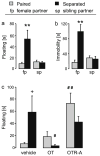Oxytocin and Social Relationships: From Attachment to Bond Disruption
- PMID: 28812266
- PMCID: PMC5815947
- DOI: 10.1007/7854_2017_10
Oxytocin and Social Relationships: From Attachment to Bond Disruption
Abstract
Social relationships throughout life are vital for well-being and physical and mental health. A significant amount of research in animal models as well as in humans suggests that oxytocin (OT) plays an important role in the development of the capacity to form social bonds, the mediation of the positive aspects of early-life nurturing on adult bonding capacity, and the maintenance of social bonding. Here, we focus on the extensive research on a socially monogamous rodent model organism, the prairie vole (Microtus ochrogaster). OT facilitates mating-induced pair bonds in adults through interaction with the mesolimbic dopamine system. Variation in striatal OT receptor density predicts resilience and susceptibility to neonatal social neglect in female prairie voles. Finally, in adults, loss of a partner results in multiple disruptions in OT signaling, including decreased OT release in the striatum, which is caused by an activation of the brain corticotropin releasing factor (CRF) system. The dramatic behavioral consequence of partner loss is increased depressive-like behavior reminiscent of bereavement. Importantly, infusions of OT into the striatum of adults prevents the onset of depressive-like behavior following partner loss, and evoking endogenous OT release using melanocortin agonists during neonatal social isolation rescues impairments in social bonding in adulthood. This work has important translational implications relevant to the disruptions of social bonds in childhood and in adults.
Keywords: Attachment; Bereavement; Grieving; Monogamy; Pair bond; Social loss.
Figures



References
-
- Ahern TH, Young LJ. The impact of early life family structure on adult social attachment, alloparental behavior, and the neuropeptide systems regulating affiliative behaviors in the monogamous prairie vole (Microtus ochrogaster) Front Behav Neurosci. 2009;3:17. doi: 10.3389/neuro.08.017.2009. - DOI - PMC - PubMed
-
- Almas AN, Degnan KA, Radulescu A, Nelson CA, 3rd, Zeanah CH, Fox NA. Effects of early intervention and the moderating effects of brain activity on institutionalized children’s social skills at age 8. Proc Natl Acad Sci U S A. 2012;109(Suppl 2):17228–17231. doi: 10.1073/pnas.1121256109. - DOI - PMC - PubMed
Publication types
MeSH terms
Substances
Grants and funding
LinkOut - more resources
Full Text Sources
Other Literature Sources

